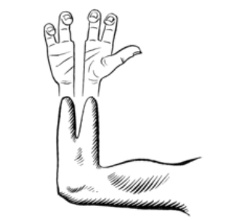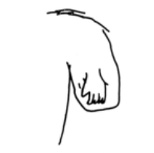A fascinating paper in the neuroscience journal Brain looks at artistic depictions of phantom limbs – the feeling of the physical presence of a limb after it has been damaged or removed – and gives a wonderful insight how the brain perceives non-functioning or non-existent body parts.
In fact, most people who have a limb amputated will experience a phantom limb, although they often fade over time.
However, the feeling is usually not an exact representation of how the actual limb felt before it was removed, but can involve curious and sometimes painful ‘distortions’ in its perceived physical size, shape or location.
The Brain article looks at the diversity of phantom limb ‘shapes’ through their visual depictions.
 The image on the left is from a 1952 case report where an amputation involved a ‘Krukenberg procedure‘.
The image on the left is from a 1952 case report where an amputation involved a ‘Krukenberg procedure‘.
This operation is rarely performed in the modern world but it involves the surgeon splitting the stump to allow pincer movements – and in this case it left the patient with the feeling of divided phantom hand.
In other cases, without any out-of-the-ordinary surgical procedure, patients can be left with a phantom that feels like the middle parts of their limb are missing while they still experience sensations in phantom extremities.
 The drawing on the right was completed by a patient in a medical case study to illustrate their experience of a post-arm-amputation phantom limb.
The drawing on the right was completed by a patient in a medical case study to illustrate their experience of a post-arm-amputation phantom limb.
In this case, the person experienced the feeling of a phantom hand on their shoulder stump, but had no experience of an intervening phantom arm.
While phantom limbs are usually associated with amputations, the phenomenon is actually caused by the mismatch between the lack of sensory input from the limb and the fact that the brain’s somatosensory map of the body is still intact and trying to generation sensations.
This means that any sensory disconnection, perhaps through nerve or spinal damage, can cause the experience of a phantom limb, even if the actual limbs are still there.
 In the drawing on the left, a patient who suffered spinal damage that caused a loss of sensation in their limbs, illustrated how their phantom legs felt.
In the drawing on the left, a patient who suffered spinal damage that caused a loss of sensation in their limbs, illustrated how their phantom legs felt.
Although their own legs were completely ‘numb’ the phantom legs felt like they were bent at the knee, regardless of where their actual legs were positioned.
Normally, feedback from real world actions and sensations keeps the somatosensory map tied to the genuine size and shape of the body, but these sensations can begin to generate distorted sensations when this connection is broken through damage.
However, the stability of our experience of body size, shape and position is remarkably flexible in everyone as the rubber hand illusion shows.
Link to locked Brain article on depictions of phantom limbs.
Great piece.
I have an upper limb amputation like the one in this piece and it it is 100% right.
I’ve never been able to explain to people how it feels apart from sometimes it’s bloody painful!